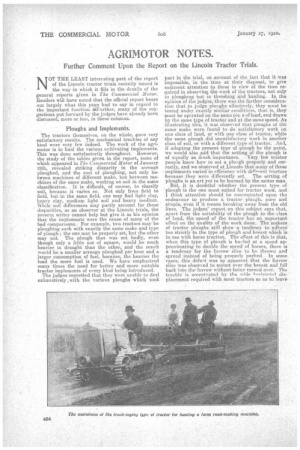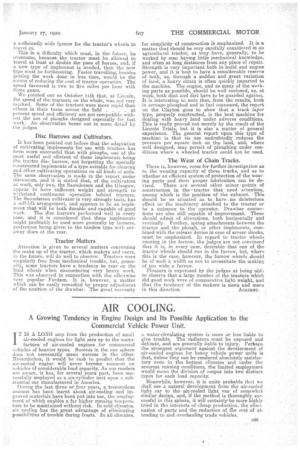AGRIMOTOR NOTES.
Page 30

Page 31

If you've noticed an error in this article please click here to report it so we can fix it.
Further Comment Upon the Report on the Lincoln Tractor Trials.
NOT THE LEAST interesting part of the report . of the Lincoln tractor trials recently issued is the way in which it fills in the details of the general reports given in The Commercial Motor. Readers will have noted that the official report bears out largely what this page had to say in regard to the important function. 41sFurther, many of the suggestions put forward by the judges have already been discussed, more or less, in these columns.
Ploughs and Implements.
The tractors themselves, on the whole, gave very satisfactory results. The mechanical troubles of any kind were very few indeed. The work of the agrimotor is to haul the various cultivating implements. This was done satisfactorily throughout. H. owever, the study of the tables given in the report, some of which appeared in The Commercial Motor of January 13th, revealed striking disparity in the acreage ploughed, and the cost of ploughing, not only between machines of different make, but between machines of the same make, working on soil in the same classification. It is difficult, of course, to classify soil, because it varies so. Not only from field to field, but in the same field, one may find light clay, heavy clay, medium light soil and heavy medium. -Mile 'soil differences may partly account for these disparities, as an observer at the Lincoln trials, the present writer cannot help but give it as his opinion that the implements were the cause of many of the bad comparisons. For example, two tractors may be ploughing each with exactly the same make and type of plough; the one may be properly set, but the other may not. The plough thatwas set badly, even though only a little out of square, would be much heavier in draught than the other, and the result would be a smaller acreage ploughed per hour and a larger consumption of fuel, because, the heavier the load the more fuel is used. We have emphasized many times the need for better and more suitable tractor implements of every kind being introduced. The judges regretted that they were unable to deal exhaustively , with the various ploughs which • took part in the trial, on-account of the fact that it was impossible, in the time at .their disposal, to give sufficient attention .to these in view of the time required in observing, the work of the tractors, not only in ploughing but in threshing and hauling. In the opinion of the judges, there was the further consideration that to judge ploughs effectively, they must be tested under exactly similar conditions, that is, they must be operated on the same pie e of land, and drawn by the same type of tractor and at the same speed. As illustrating this, it was observed that ploughs of the same make were found to do satisfactory work on one class of land, or with one class of tractor, while the same plough did unsatisfactory work in another class of sod, or with a different type of tractor. And, if adapting the present type of plough be the point, we would also add that the setting of the plough is of equally as much importance. Very few traCtor people know how to set a plough properly and correctly, and we observed at .Lincoln that many of these implements varied in efficiency with difF4-sent tractors because they were differently set. The setting of ploughs is an art yet to be learned by the motor man. But, it is doubtful whether the present type of plough is the one most suited for tractor work, and I think attention should be concentrated upon the endeavour to produce a tractor plough, pure and simple, even if it means breaking away from the old lines. The judges' report on this subject-says that, apart from the suitability of the plough to the class of .land, the speed of the tractor has an important effect on the quality of the work done. The makers of tractor ploaghs still show a tendency to adhere too strictly to the type of plough and breast which is in use with horse traction. The effect of this is that, when this type of plough is hailed at a speed approximating to double the speed of horses, there is a tendency for the furrow slice to be thrown and spread instead of being properly packed. In some cases, this defect was sp apparent that the furrow slice was observed to mount over the breast and fall back into the furrow without being turned over. The trouble is accentuated by the wide 3,n,•i7rintA (ligplacement required with most tractors so as to leave a sufficiently wide fisrrow for the tractor's wheels to travel m.
This is a difficulty which must, in the future, be overcome, because the tractor must be allowed to travel at least at double, the pace of hoises, and, if a new type of implement is needed, then the new type must be forthcoming. Faster travelling, besides getting the work done in less time, would be the means of reducing the cost of tractor operation. The speed favoured is two to five miles per hour with three gears.
We pointed out on October 14th that, at Lincoln, the speed of the tractors, on the whole, was not very marked. Some of the tractors were more rapid than others in their turns across the field . . . . present speed and efficiency are not compatible without the use of ploughs designed especially for fast work. An observation borne out in more detail by the judges.
Disc Harrows and Cultivators.
It has been pointed out before that the adaptation of cultivating implements for use with tractors has been more successful than with ploughs, one of the most useful and efficient of these implements being the tractor disc harrow, not forgetting the specially eoustructed implements of a type suitable for clearing and other cultivating operations on all kinda of soils. The same observation is made in the report under discussion, and it is stated that, of the cultivators at work, only two, the Saunderson and the Glasgow, appear to have sufficient weight and strength to withstand continuous operation behind tractors. The Saunderson cultivator is very strongly built, has a self-lift arrangement, and appears to be an implement that will be both durable and capable of good -work. The disc harrows performed well in every case, and it is considered that these implements !night profitably be used more generally by farmers, preference being given to the tandem type with cutaway discs at the rear.
Tractor Matters
Attention is given to several matters concerning the make up of the tractor, which makers and users, in the future, will do well to observe. Tractors were singularly free from Mechanical trouble, but, gener:ally, some tractors have a tendency to rear on the hind wheels when' encountering very heavy work. This was observed in connection with the otherwise very popular Fordson. It is, however, a matter which can be easily 'remedied by proper adjustment of the position of the drawbar. The great necessity for simplicity of construction is emphasized. It is a matter that should be very carefully considered in an agricultural tractor, as they have, generally, to be worked by men having little mechanical knowledge, and often at long distances from any place of repair. Strength is very important both in build and engine power, and it is best to have a considerable reserve of both, as, through a sudden and great variation of land, a heavy strain is often quickly imparted to the machine. The engine, and as many of the working parts as possible,' should be well enclosed, as, at work, both dust and dirt have to be guarded against. It is-interesting to note that, from the results, both in acreage ploughed and in fuel consumed, the report on the Clayton goes to show that a track layer type, properly constructed, is the best machine for dealing with heavy land under adverse conditions. This is really proved not merely by the result of the Lincoln Trials, but it is also a matter of general experience. The general report upon this type of machine is that its use undoubtedly reduces the pressure per square inch • on the land, and, where well designed, may permit of ploughing under conditions where a wheeled tractor could not be used.
The Wear of Chain Tracks.
There is, however, room for further-investigation as to the wearing capacity of these tracks, and as to whether an efficient system of protection of the wearing parts and their proper lubrication can be de vised. There are several other minor 'points of construction in the tractor that need attention, among which is the position of the exhaust. This should be so situated as to have no deleterious effect on the machinery attached to the tractor or be a nuisance to the operator. Drawbar connections are also still capable of improvement. These should admit of alterations, both horizontally and vertically. Further, spring attachments between the tractor and the plough, or other implements, combined with the release device in case of severe shocks, must be emphasized. In regard to tractor wheels running in the furrow, the judges are not convinced that it is, in every case, desirable that one of the tractor wheels should run in the furrow, but, where this is the case, however, the furrow wheels should be of such a width as not to necessitate the making of too wide a furrqw.
Pleasure is expressed by the judges at being able to observe that a large number of the tractors which did good work were of comparative light weight, and that the tendency of the makers is more and more in this direction. AGRIMST.


































